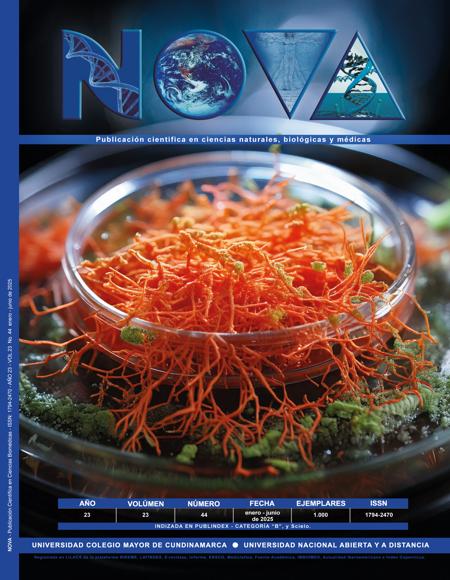Study of Biomolecules with Inhibitory Activity on Helicobacter pylori in Colombian Patients with High Risk of Gastric Cancer
Estudio de Biomoléculas con Actividad Inhibitoria sobre Helicobacter pylori en Pacientes Colombianos con Alto Riesgo de Cáncer Gástrico

This work is licensed under a Creative Commons Attribution-NonCommercial-ShareAlike 4.0 International License.
Show authors biography
Introduction. Gastric cancer in Nariño represents a significant public health problem due to its high incidence and mortality rates. Eradicating Helicobacter pylori is a key strategy for preventing this disease, but the failure of some treatments has prompted the search for alternatives, such as the use of natural compounds. Among these, Brassica oleracea var. Itálica and Cannabis sativa extracts rich in cannabidiol stand out.
Objective. To evaluate the in vitroinhibitory activity of broccoli and Cannabis sativa extracts rich in cannabidiol on the growth of Helicobacter pyloriisolated from patients with gastric disease in Nariño. Methodology. Helicobacter pyloriwas isolated and purified from gastric biopsies of patients from the Department of Nariño. Brassica oleraceavar. Itálica extracts, with high sulforaphane content, were obtained using rotaevaporation and lyophilization techniques. The Cannabis sativa extract was obtained using supercritical CO₂ extraction. The inhibitory activity of the extracts was evaluated using the agar dilution method, colony-forming units (CFU) were counted using ImageJ software, and the minimum inhibitory concentration (MIC) for each isolate was determined.
Results. The MIC of Brassica oleracea var. Itálica extracts with high sulforaphane content was 120 µg/mL. The MIC of the Cannabis sativa extract was 55 µg/mL.
Conclusion. Brassica oleracea var. Itálica and Cannabis sativaextracts rich in cannabidiol exhibit an inhibitory effect on the in vitro growth of Helicobacter pyloriisolated from patients in Nariño, with the Cannabis sativa extract being the most effective.
Article visits 53 | PDF visits 25
Downloads
- Bray F, Laversanne M, Sung H, Ferlay J, Siegel RL, Soerjomataram I, et al. Global cancer statistics 2022: GLOBOCAN estimates of incidence and mortality worldwide for 36 cancers in 185 countries. CA Cancer J Clin. 2024;74(3):229–63.
- Correa P. Cáncer gástrico: una enfermedad infecciosa. Rev Colomb Cir. 2011;26:111–7.
- Atehortua Rendon JD, Pérez Cala TL, Martínez A. Descripción de la resistencia de Helicobacter pylori a seis antibióticos de uso frecuente en Colombia. Rev Colomb Gastroenterol. 2020;35(3):351–61.
- Gutiérrez-Escobar AJ, Méndez-Callejas G, Acevedo O, Bravo MM. Rapid evolution of the Helicobacter pylori AlpA adhesin in a high gastric cancer risk region from Colombia. PeerJ. 2018;2018(5):1–20.
- Bedoya-Urresta Á, Yépez Y, Calvache D, Cifuentes Y, Lucero N, González P, et al. Proyecto Urkunina 5000-Investigación de la prevalencia de lesiones precursoras y del efecto de la erradicación de Helicobacter pylori como prevención primaria del cáncer gástrico en el departamento de Nariño. Rev Colomb Cirugía. 2018;33(4):345–52.
- Lv X, Meng G, Li W, Fan D, Wang X, Espinoza-Pinochet CA, et al. Sulforaphane and its antioxidative effects in broccoli seeds and sprouts of different cultivars. Food Chem. 2020;316(January):1–8.
- Delgado-Córdoba X, Quiñones-Criollo F. Optimización de la Extracción de Cannabinoides de Cannabis sativa Utilizando CO2 Supercrítico. Universidad de Nariño; 2020.
- Figueroa M, Cortés A, Pazos Á, Bravo LE. Sensibilidad in vitro a amoxicilina y claritromicina de helicobacter pylori obtenido de biopsias gástricas de pacientes en zona de bajo riesgo para cáncer gástrico. Biomedica. 2012;32(1):32–42.
- Bayona Rojas MA. Condiciones microbiológicas para el cultivo de Helicobacter pylori. Rev Colomb Gastroenterol [Internet]. 2013;28(2):94–9. Available from: http://www.scielo.org.co/scielo.php?script=sci_arttext&pid=S0120-99572013000200002&lng=en&nrm=iso&tlng=es
- Thirunavukkarasu P, Asha S, Kumarreddy R, Ramanathan T, Sudhakar N. Survey, isolation, biochemical characterization, and identification of Helicobacter pylori from gastric patient biopsy. Asian J Pharm Clin Res. 2017;10(6):411–6.
- Eraso-Escobar P. Polifenoles del aguacate Persea americana y su efecto sobre el crecimiento de Helicobacter pylori aislado de una población de alto riesgo de cáncer gástrico de Nariño-Colombia. Universidad de Nariño; 2018.
- Fahey JW, Haristoy X, Dolan PM, Kensler TW, Scholtus I, Stephenson KK, et al. Sulforaphane inhibits extracellular, intracellular, and antibiotic-resistant strains of Helicobacter pylori and prevents benzo[a]pyrene-induced stomach tumors. Proc Natl Acad Sci U S A. 2002;99(11):7610–5.
- Fahey JW, Stephenson KK, Wade KL, Talalay P. Urease from Helicobacter pylori is inactivated by sulforaphane and other isothiocyanates. Biochem Biophys Res Commun. 2013 May 24;435(1):1–7.
- Mangla B, Javed S, Sultan MH, Kumar P, Kohli K, Najmi A, et al. Sulforaphane: A review of its therapeutic potentials, advances in its nanodelivery, recent patents, and clinical trials. Phyther Res. 2021;35(10):5440–58.
- Baenas N, Moreno D, García-Viguera C. Glucosinolatos Mecanismo De Accion. Rev Iberoam Interdiscip Métodos, Model y Simulación. 2018;10:69–78.
- Le TN, Chiu CH, Hsieh PC. Bioactive compounds and bioactivities of Brassica oleracea L. Var. Italica sprouts and microgreens: An updated overview from a nutraceutical perspective. Plants. 2020;9(8):1–23.
- Mannion A, Dzink-Fox JA, Shen Z, Blanca Piazuelo M, Wilson KT, Correa P, et al. Helicobacter pylori antimicrobial resistance and gene variants in high- And low-gastric-cancer-risk populations. J Clin Microbiol. 2021;59(5):1–13.
- Matta A, Zambrano D, Pazos A. Punctual mutations in 23S rRNA gene of clarithromycin-resistant Helicobacter pylori in Colombian populations. World J Gastroenterol. 2018;24(4):172–229.
- Jokić S, Jerković I, Pavić V, Aladić K, Molnar M, Kovač MJ, et al. Terpenes and Cannabinoids in Supercritical CO2 Extracts of Industrial Hemp Inflorescences: Optimization of Extraction, Antiradical and Antibacterial Activity. Pharmaceuticals. 2022;15(9).
- Mayyas A, Abu-Sini M, Amr R, Akasheh R, Zalloum W, Khdair A, et al. Novel in vitro and in vivo anti-Helicobacter pylori effects of pomegranate peel ethanol extract. vetworld. 2021;14(1).
- Lawal TO, Igbokwe CO, Adeniyi BA. Antimicrobial activities and the Bactericidal Kinetics of Allium ascalonicum Linn. (Whole plant) against standard and clinical strains of Helicobacter pylori: Support for Ethnomedical Use. J Nat Sci Res. 2014;4(8):48–57.
- Krzyżek P, Junka A, Słupski W, Dołowacka-Jóźwiak A, Płachno B., Sobiecka A, et al. Antibiofilm and Antimicrobial-Enhancing Activity of Chelidonium majus and Corydalis cheilanthifolia Extracts. Pathogens. 2021;10.
- Pazos AJ, Eraso P, Martinez V. Polyphenolic biofrations extracted from avocado (Persea americana var. HASS ) on the growth of Helicobacter pylori in S-572. Gastroenterology [Internet]. 2020;158(6):S-572. Available from: http://dx.doi.org/10.1016/S0016-5085(20)32139-9
- Malfertheiner P, Megraud F, Morain CAO, Gisbert JP, Kuipers EJ, Axon AT, et al. Management of Helicobacter pylori infection: Maastricht V / Florence consensus report. Gut. 2017;66(1):6–30.
- Wassmann CS, Højrup P, Klitgaard JK. Cannabidiol is an effective helper compound in combination with bacitracin to kill Gram-positive bacteria. Sci Rep. 2020;10(1):1–12.









